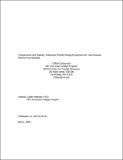| dc.description.abstract | Aquatic invasions of nonindigenous species have increased dramatically due to the globalization of consumer goods, which relies on shipping to connect once isolated marine environments (Bright 1999, Barbier and Shogren 2004, Perrings et al. 2005). European waters have been shown to pose a particularly high threat to the northeastern United States due to the disproportionately large amount of shipping arriving from the area (Dassuncao 2008 unpublished) and the presence of invasive species, from regions outside Europe, currently established in European countries (Molnar et al. 2008). One European invader thought to be especially likely to arrive in the near future is the Australasian barnacle, Austrominius (=Elminius) modestus, (J. Pederson, MITSG, 2008), which has a long history in European waters (Crisp 1958, Harms and Anger 1989). Because A. modestus has been present in Europe for over 60 years, the question is why has it not appeared in the U.S? As fouling organisms, barnacles are among those species that are spread readily as invaders. | en_US |
